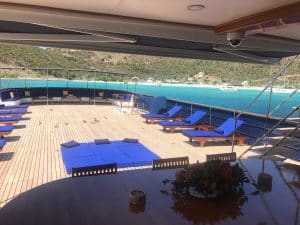Imagine standing on the deck of a ship, feeling the ocean breeze on your face and the rolling waves beneath your feet, as you embark on an exciting journey across the vast seas. If this sounds like a dream come true, then a career as a deckhand might be the perfect fit for you. In this article, we will guide you through the essential steps to become a successful deckhand, from acquiring the necessary skills and qualifications to building your professional network in the maritime industry. We will also share valuable tips for landing your first deckhand job on a vessel and discuss opportunities for growth and development in this rewarding career. Lastly, we will address the importance of staying safe and adapting to life at sea as a deckhand. So, get ready to set sail on a thrilling adventure as we navigate the path to becoming a deckhand.
1. Essential Skills and Qualifications for a Successful Deckhand Career
Embarking on a career as a deckhand requires a specific set of
skills and qualifications to ensure success in this demanding profession. One of the most crucial abilities is having a strong work ethic, as deckhands often work long hours in challenging conditions. Additionally, being a team player is vital, as deckhands must collaborate with other crew members to maintain the vessel and ensure smooth operations.
Physical fitness is also a significant factor, as the job entails heavy lifting and manual labor. Furthermore, possessing excellent communication skills and a keen attention to detail will help you excel in this role.
When it comes to qualifications, obtaining a
STCW (Standards of Training, Certification, and Watchkeeping) certificate is essential for working on commercial vessels. This internationally recognized certification covers basic safety training, first aid, and firefighting. Additionally, having a
Powerboat Level 2 license or a
Yachtmaster qualification can be advantageous, as it demonstrates your competency in operating small vessels. While there are many pros to a deckhand career, such as the opportunity to travel and work in a dynamic environment, it’s essential to consider the cons, such as the physical demands and long hours away from home. Ultimately, a successful deckhand career requires dedication, hard work, and a passion for the maritime industry.
2. Acquiring the Necessary Training and Certifications for Deckhands
Before you can begin your journey as a deckhand, it’s essential to acquire the appropriate training and certifications.
Many maritime schools and training centers offer courses specifically designed for aspiring deckhands. These courses typically cover essential skills such as knot tying, line handling, safety procedures, and basic navigation. Additionally, you may want to consider taking specialized courses in areas such as firefighting, first aid, and personal survival techniques.
When it comes to certifications, there are a few key ones that you’ll need to obtain to work as a deckhand. These include:
- STCW (Standards of Training, Certification, and Watchkeeping) Basic Safety Training: This internationally recognized certification covers basic safety training in personal survival techniques, fire prevention and firefighting, elementary first aid, and personal safety and social responsibilities.
- ENG1 Medical Certificate: This certificate confirms that you are medically fit to work at sea and is required by most employers.
- Proficiency in Designated Security Duties (PDSD): This certification is required for crew members with specific security responsibilities on board a vessel.
Once you have completed the necessary training and obtained the required certifications, you’ll be well-prepared to start your career as a deckhand.
Networking and gaining practical experience through internships or entry-level positions will also be crucial in helping you secure a job in the industry. Remember, becoming a successful deckhand takes time, dedication, and a willingness to learn and grow in your role.
3. Building Your Professional Network in the Maritime Industry
In order to become a successful deckhand, it is crucial to
build a strong professional network within the maritime industry. This can be achieved by following these steps:
- Attend industry events such as conferences, workshops, and seminars to meet like-minded professionals and learn about the latest trends and opportunities in the maritime sector.
- Join
professional associations and organizations related to the maritime industry, as they often provide networking opportunities and access to valuable resources. - Utilize
social media platforms like LinkedIn to connect with professionals in the industry and showcase your skills and experience. - Consider
volunteering or interning with maritime companies or organizations to gain hands-on experience and make valuable connections. - Don’t be afraid to
reach out to professionals you admire for advice or mentorship, as they can provide invaluable insights and guidance on your career path.
By actively engaging in these networking activities, you will be better positioned to
find job opportunities and establish a successful career as a deckhand in the maritime industry.
4. Tips for Landing Your First Deckhand Job on a Vessel
Securing a position as a deckhand on a vessel can be a challenging yet rewarding experience.
Networking is crucial in this industry, so make sure to attend boat shows, yacht clubs, and marinas to meet potential employers and other professionals in the field. Additionally, consider joining online forums and social media groups related to the maritime industry to expand your network and stay informed about job opportunities.
Obtaining relevant certifications can significantly increase your chances of being hired as a deckhand. Some of the essential certifications include the Standards of Training, Certification, and Watchkeeping (STCW), and the Powerboat Level 2 certificate. Additionally, having a strong background in water sports, such as sailing or diving, can be a valuable asset. Remember to highlight these skills and certifications on your resume and during interviews.
Lastly,
gaining hands-on experience is vital for aspiring deckhands. Volunteering on boats or working at marinas can provide you with practical knowledge and skills that will be useful in your future career. Moreover, these experiences can serve as excellent references when applying for deckhand positions. Be prepared to start at an entry-level position and work your way up, as this will demonstrate your commitment and passion for the maritime industry.
5. Advancing Your Deckhand Career: Opportunities for Growth and Development
As a deckhand, it is essential to continuously
improve your skills and knowledge in order to advance in your career. One way to achieve this is by attending specialized training courses and obtaining relevant certifications. For instance, you can pursue courses in navigation, marine engineering, or even yacht management. Additionally, participating in workshops and seminars related to the maritime industry can help you stay updated on the latest trends and best practices. It is also crucial to network with professionals in the field, as this can open up new opportunities for growth and development.
A
checklist for advancing your deckhand career may include the following items: obtaining necessary certifications, attending training courses, participating in industry events, networking with professionals, and gaining experience in various roles on board. By focusing on these areas, you can enhance your expertise and increase your chances of securing higher-level positions, such as a bosun, mate, or even captain. Remember that
hard work, dedication, and a willingness to learn are key factors in achieving success in the maritime industry.
6. Staying Safe and Adapting to Life at Sea as a Deckhand
Adapting to life at sea as a deckhand requires a strong focus on safety and the ability to quickly acclimate to the unique challenges of working on a vessel. One of the most crucial aspects of staying safe on board is having a thorough understanding of the ship’s safety procedures and equipment. This includes knowing the location and proper use of life jackets, life rafts, fire extinguishers, and emergency signals. Additionally, it is essential to participate in regular safety drills and maintain a
checklist to ensure all safety equipment is in good working order.
Physical fitness and stamina are also vital components of a deckhand’s ability to stay safe and adapt to life at sea. The demanding nature of the job requires long hours of manual labor, often in challenging weather conditions. Regular exercise, proper nutrition, and adequate rest are essential for maintaining the physical and mental resilience needed to perform at a high level. Furthermore, it is crucial to be aware of one’s surroundings and maintain clear communication with fellow crew members to prevent accidents and ensure the smooth operation of the vessel.
Lastly, adapting to life at sea as a deckhand involves developing a strong sense of camaraderie and teamwork with fellow crew members. Living and working in close quarters can be challenging, but it is essential to maintain a positive attitude and foster a supportive environment. This includes respecting the privacy and personal space of others, being willing to lend a hand when needed, and actively participating in shared responsibilities such as cooking and cleaning. By cultivating a strong sense of
teamwork and maintaining a focus on safety, deckhands can successfully navigate the challenges of life at sea and excel in their roles.
Frequently Asked Questions
1. What are the typical daily tasks of a deckhand?
- A deckhand’s daily tasks include maintaining the cleanliness of the vessel, assisting with docking and undocking, handling lines and ropes, performing basic maintenance tasks, and assisting with other crew members’ tasks as needed. Deckhands may also be responsible for operating small boats, such as tenders or lifeboats, and participating in safety drills and training.
2. How long does it take to become a qualified deckhand?
- The time it takes to become a qualified deckhand varies depending on the individual’s background and the specific training and certifications required for the job. Generally, it can take anywhere from a few months to a couple of years to gain the necessary experience, training, and certifications to become a deckhand.
3. What are the physical requirements for a deckhand?
- Deckhands must be physically fit and able to perform tasks that require strength, stamina, and agility. They should be comfortable working in confined spaces, at heights, and in various weather conditions. Good hand-eye coordination and manual dexterity are also important, as deckhands often handle ropes, lines, and other equipment.
4. Are there any specific certifications required to work as a deckhand?
- While specific certifications may vary depending on the type of vessel and the country in which you are working, some common certifications for deckhands include the Standards of Training, Certification, and Watchkeeping for Seafarers (STCW) Basic Safety Training, and the Maritime and Coastguard Agency (MCA) Efficient Deckhand certification. Additional certifications, such as first aid or firefighting, may also be required or beneficial in securing a deckhand position.
5. What is the typical career progression for a deckhand?
- Deckhands can progress in their careers by gaining experience, further training, and additional certifications. They may advance to positions such as lead deckhand, bosun, or even officer roles, depending on their qualifications and the size of the vessel. Some deckhands may also choose to specialize in a particular area, such as engineering or navigation, and pursue career opportunities in those fields.











